Last Updated on March 2, 2022
When you get behind the wheel you expect all the gauges and lights in front of you to work. So it can be more than a little disconcerting when one of those helpful gauges stops working as it should.
What do you do when your fuel gauge starts reading incorrectly, and what does it mean? More importantly, how do you fix it?
We’ll break it all down for you here, that way you know exactly what’s going on, and you can get accurate readings again.
How a Fuel Gauge Works
In older vehicles, when you turn the key to the ON position or start your car, you watch the fuel gauge go to full, back to empty, and then to the position that highlights the current amount of fuel in your vehicle.
Modern vehicles often use a digital display, but the way they operate is pretty much the same. It all starts inside the fuel tank.
Inside the tank, there is a part called a float gauge or a fuel sending unit. It works a bit like a bobber when you’re fishing. At the end is a buoyant part that sits on top of the fuel and it’s attached to a two-part metal rod with a split in the middle.
This split allows the rod to bend, and it turns the entire device into a mechanical arm that can keep the buoyant part of the gauge on top of the fuel regardless of whether you have a near-empty tank or a full one.
The float gauge actively measures the bend in the arm, and it converts this bend into an electrical signal that it sends to the fuel gauge.
A fully extended float gauge sends an electrical signal that the gauge translates into “full,” while one that is almost completely bent in half translates a signal that means “empty.”
Everything else falls in between, and that’s how the fuel gauge shows you how much fuel is in the tank. Most of the time the signal heads through the ECM before heading to the fuel gauge, but it really depends on your vehicle.
Here’s a short video to help you understand how a fuel gauge works:
See Also:
- Water In Your Gas Tank (Symptoms and How to Fix)
- What Happens If Someone Puts Sugar In Your Gas Tank?
- What Happens If Someone Pours Bleach In Your Gas Tank?
How Accurate Are Fuel Gauges?
If the fuel gauge is working properly, it’s extremely accurate outside of a few scenarios.
Scenario #1 – After Filling Up
The first is when you fill-up the tank. You’ve likely noticed that it takes a little while for the fuel gauge to start going down after you fill up, and that has to do with the placement inside the tank.
Manufacturers typically mount the float gauge near the top of the tank, not at the very top. This gap leads to a bit of delay when showing you the reading. After the gap is gone, a properly functioning fuel gauge gives you very accurate results.
Scenario #2 – Fuel Tank Almost Empty
The second scenario is when your tank is near empty. Many float gauges won’t reach the bottom of the tank, so it’s completely possible to have an empty reading while there’s still some fuel in the tank.
Scenario #3 – Driving On an Incline

Finally, anytime you’re on an incline it’s going to throw the reading off. The fuel will settle towards the lowest part of the vehicle, but your fuel gauge is going to stay in the same spot.
If it’s near the lower part of the vehicle, it’ll show that you have more fuel than you do, and if it’s near the higher part of the vehicle, it’ll show that you have less. Once you get the vehicle back on a level surface, you should get an accurate reading again.
Causes of a Malfunctioning Fuel Gauge
If your fuel gauge isn’t working the way it should, there are a few potential causes and symptoms that you need to address. We’ll dive into three different ways that the fuel gauge can act up here, then we’ll dive into what can cause each issue.
Malfunction Type #1 – Gauge Reads Empty When Tank is Full
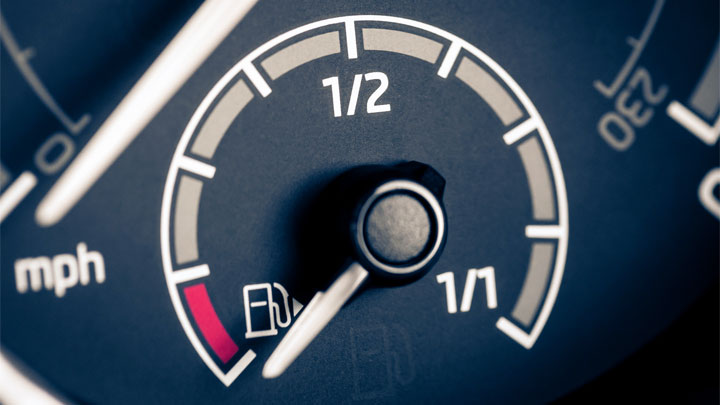
If you can’t ever get your fuel gauge to read full, the most likely problem is either a faulty fuel gauge or a frayed electrical connection.
Most fuel gauges read full when they’re getting maximum power, so if they don’t have any power, then they’ll always read empty.
Of course, the problem could be a broken float gauge too, because if that doesn’t send any signal then it’ll always read empty too. Before you dive too far into anything here, check fuses and for power at the gauge.
Malfunction Type #2 – Gauge Stuck on Full
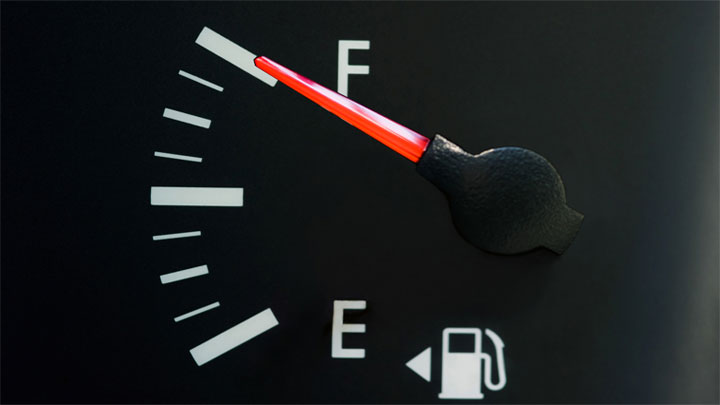
If your fuel gauge always reads full, it’s either because the fuel gauge itself is faulty and stuck on full, or the float gauge is always sending a full signal. A lot of the time you can tell which part is faulty by simply looking if the fuel gauge resets to empty when you turn the vehicle off.
However, this completely depends on the type of vehicle you drive because some fuel gauges lock at their last setting. But if your vehicle typically cycles on and off, and it doesn’t cycle now, the problem is likely the fuel gauge in the dash.
Malfunction Type #3 – Gauge Fluctuates Up and Down
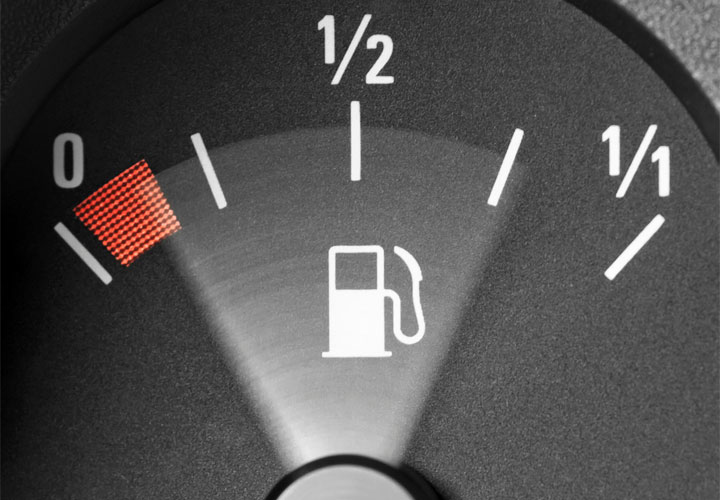
This is the most complicated condition to diagnose because there are a few potential causes. You might have a faulty float gauge or fuel gauge in the dash, but the problem likely won’t be as easy to diagnose.
One possible explanation is that the float gauge is now a bit too loose. When you go over bumps and dips in the road, the fuel gauge can hop up and down causing your fuel gauge reading to fluctuate.
It could also be part of a normal condition. For instance, if you park on a hill, then it’s normal for the fuel reading to change. That’s because the fuel follows gravity, and wherever the float sits will rise or fall. Once you level the vehicle out, you’ll go back to getting an accurate reading.
Related: Code P0463
How to Fix a Gas Gauge (and Repair Cost)
For replacement parts, we recommend: PartsGeek.com
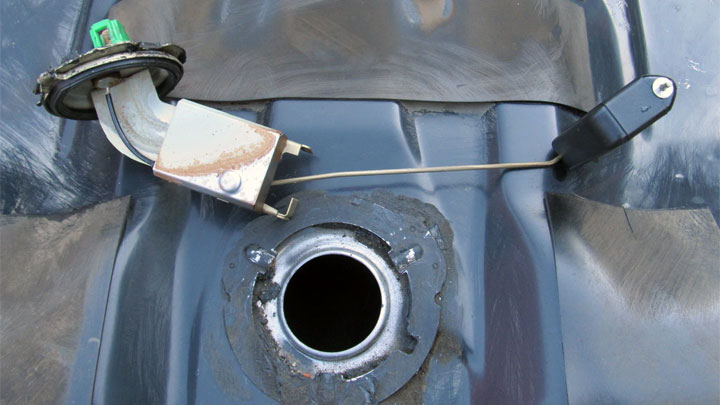
Fixing a faulty gas gauge requires a bit of troubleshooting, but if you have the right tools it’s not that hard of a job.
Always start by ruling out the easy stuff. For this job, that’s the fuses and circuit breakers. Once you rule them out, we highly recommend using an OBD-II scan tool. Hook up the tool and look for the fuel reading.
If you’re getting an accurate fuel reading on the automotive scan tool, then the problem is with the gauge, not the float gauge. However, if you’re not getting the correct reading on the scan tool, then chances are the problem is with the float gauge.
While you can check this manually by testing for power at the gauge, the scan tool saves you from having to tear apart the dash if the problem is with the float gauge.
If the problem is with the gauge itself, pull apart the dash and check for power at the gauge. If everything is powered up like it should be, replace the gauge. If the scan tool reading is right and the gauge isn’t getting any power, check the electrical connection between the gauge and the ECM — there’s likely a break somewhere.
If the scan tool points you towards the float gauge, repeat the same process there. There’s a good chance that the problem is one of the two gauges though. While electrical wiring issues do happen, they’re definitely a rarer occurrence.
Below we’ve created a chart that breaks down the estimated repair costs depending on the exact problem with your vehicle. Keep in mind that the prices vary quite a bit depending on what you drive. For example, some aftermarket float gauges only cost about $50, while others can cost up to $700 or more!
Cost to Fix a Malfunctioning Gas Gauge
| Problem | DIY Cost | Repair Shop Cost |
|---|---|---|
| Faulty Fuse/Circuit Breaker | $1 to $20 | $10 to $40 |
| Faulty Fuel Gauge | $50 to $200 | $250 to $500 |
| Fault Float Gauge | $50 to $700 | $250 to $1000 |
| Electrical Wiring Issue | $30 to $60 | $250 to $450 |

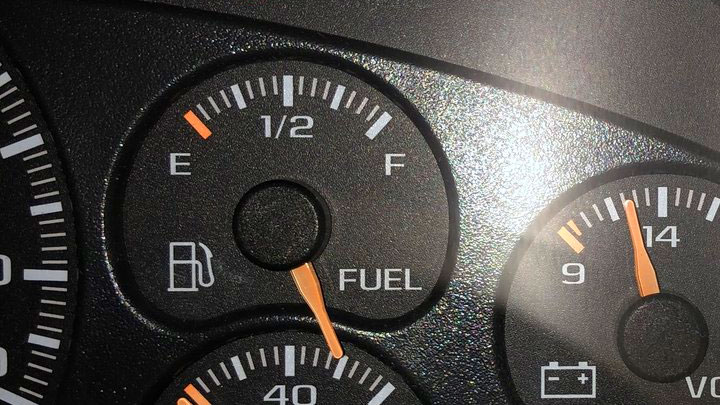



I just installed an 8 gallon fuel cell Made by Dingeter D G 3806. I also installed a new gauge made by AtFWEL voltage d c 12 volt. All new wiring tank to gauge. My gauge reads full when ign . turned on. Gauge goes to empty when ign. turned off. Tank is about 1/4 full. Thank You for your help.